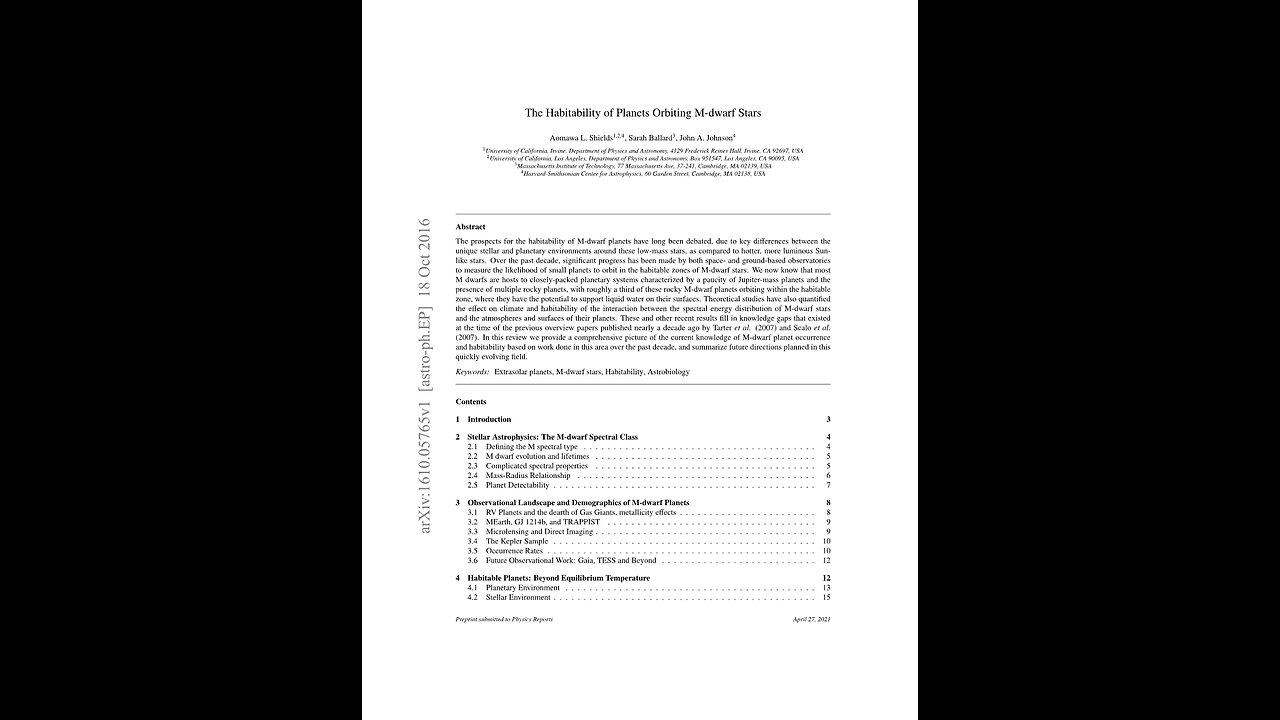Premium Only Content

The Habitability of Planets Orbiting M-dwarf Stars
Index of Other Science Articles:
https://rumble.com/v3t4yzj-index-of-science.-music-by-dan-vasc.html
The Habitability of Planets Orbiting M-dwarf Stars
Aomawa Shields, Sarah Ballard, and John Johnson.
University of California, Irvine, University of California, Los Angeles,
Massachusetts Institute of Technology and Harvard-Smithsonian Center for Astrophysics.
Physics Reports Volume 663, 5 December 2016, Pages 1 to 38.
https://www.sciencedirect.com/science/article/abs/pii/S0370157316303179
https://doi.org/10.1016/j.physrep.2016.10.003
Abstract.
The prospects for the habitability of M-dwarf planets have long been debated, due to key differences between the unique stellar and planetary environments around these low-mass stars, as compared to hotter, more luminous Sun like stars. Over the past decade, significant progress has been made by both space and ground-based observatories to measure the likelihood of small planets to orbit in the habitable zones of M-dwarf stars. We now know that most M dwarfs are hosts to closely-packed planetary systems characterized by a paucity of Jupiter-mass planets and the presence of multiple rocky planets, with roughly a third of these rocky M-dwarf planets orbiting within the habitable zone, where they have the potential to support liquid water on their surfaces. Theoretical studies have also quantified the effect on climate and habitability of the interaction between the spectral energy distribution of M-dwarf stars and the atmospheres and surfaces of their planets. These and other recent results fill in knowledge gaps that existed at the time of the previous overview papers published nearly a decade ago by Tarter et al and Scalo et al in two thousand and seven. In this review we provide a comprehensive picture of the current knowledge of M-dwarf planet occurrence and habitability based on work done in this area over the past decade, and summarize future directions planned in this quickly evolving field.
Keywords: Extrasolar planets, M-dwarf stars, Habitability, Astrobiology.
One. Introduction.
What was once the realm of science fiction, Earth-sized planets outside of the Solar System, where life might exist, is now scientific fact. At the time of writing, over three thousand confirmed planets have been discovered orbiting other stars. Many of these planets are especially captivating because of their orbital distances, which place them in their stars’ canonical habitable zone, the region around a star where an orbiting planet with an Earth-like atmosphere, Carbon Dioxide, water vapor, and Nitrogen, could maintain water in liquid form on its surface.
The mass and radius distribution of these habitable-zone planets is power-law in shape, rising steeply toward smaller planets with planetary radii less than around 1.6 EARTH RADII. Thus, many of the small planets detected by NASA’s Kepler mission are likely to have rocky surfaces like the Earth. On Earth, where there is water, there is life. Therefore such planets are exciting prospects to consider in the search for life outside of the Solar System.
However, recent advances in theoretical research have revealed the myriad factors that contribute to determining a planet’s habitability beyond orbital distance from its parent star. Specifically, the interaction between a star and orbiting planets can induce both radiative and gravitational effects on planetary climate. These effects are now entering into the larger discussion of habitability. Additionally, an understanding of how these processes might change for different host stars and planetary system architectures has expanded and deepened, which will inform the prioritization of planets for follow-up by future characterization missions. Identifying the planetary systems that have the highest likelihood of hosting a water- and possibly life-bearing world, as well as the properties, whether stellar or planetary, that have the largest influence on long-term habitability, is of chief importance to the fields of astrobiology and exoplanet astronomy.
Interest in M-dwarf stars as hosts for habitable planets has increased markedly over the last twenty years as the field of exoplanet discovery and characterization has grown. Since M dwarfs comprise approximately 70 percent of all stars in the galaxy, they offer the best chance of finding habitable planets through sheer numbers and proximity to the Sun. They also offer clear observational advantages. Small planets are easier to detect orbiting small stars via the radial velocity and transit techniques, as spectroscopic Doppler shifts and photometric transit depths are larger due to the smaller star-to-planet mass and size ratios, respectively. Also, because of the relatively low temperatures and luminosities of M dwarfs, their habitable zones are much closer to the stars than those of Sun-like stars, increasing the geometric probability of observing a transit, as well as the frequency of transits of habitable-zone planets during a given observational time period. Small planets orbiting small, low-mass stars are also better suited to the application of transmission spectroscopy methods to characterize their atmospheres.
Additionally, the lengthy stellar lifetimes of M-dwarf stars is a benefit. The “dwarf" classification is assigned to stars that are in the main-sequence phase of stellar evolution, converting hydrogen to helium in their cores. Every M star that has ever formed is still on the Main Sequence. This is because M-dwarf stars, given their low masses, burn their nuclear fuel at vastly slower rates compared to Sun-like or brighter stars. They are therefore extremely long-lived, with main-sequence lifetimes of trillions of years for the lowest-mass M dwarfs. They would therefore offer plentiful timescales for planetary and biological development and evolution on orbiting planets.
However, the prospects for the habitability of planets orbiting M-dwarf stars have long been debated, due to key differences between the unique stellar and planetary environments around these stars, and the environments of hotter, brighter stars. Previous overview papers of nearly a decade ago summarized the current understanding of the instrumental requirements for observing M-dwarf planets, and addressed outstanding questions concerning the impact on surface life of stellar flare activity, synchronous rotation, and the likelihood of photosynthesis on M-dwarf planets. However, at the time of these papers, no terrestrial-sized planets had yet been discovered around M-dwarf stars, and no statistical information about the occurrence rate of exoplanets as a function of stellar type was available. Additionally, the use of multidimensional climate models to explore how planets orbiting stars other than the Sun achieve global energy balance as a function of their stellar and planetary environments was not prevalent.
Over the past decade, major progress has been made by both space and ground-based observatories, and theoretical modelers, to more precisely measure the likelihood of small planets to orbit in the habitable zones of M-dwarf stars, and the effect on climate and habitability of the unique stellar and planetary environments of M dwarfs. About 200 exoplanets have been found around M-dwarf stars, many in their stars’ habitable zones. These planets have been found through radial velocity (RV) methods, transit detection missions such as NASA’s Kepler mission and the K2 mission, an ecliptic plane survey that re-purposes the Kepler spacecraft following the loss of two of its reaction wheels, and gravitational micro-lensing. With the unveiling of the next generation of telescopes in the coming decade, we expect to find more of these planets, ushering in a new era that will use both observational and theoretical methods together to generate a prioritized target list of potentially habitable planets to follow up on with future missions to characterize their atmospheres. As discussed in the following sections, both observational data and modeling efforts indicate that the best place to look for habitable planets may be around M-dwarf stars.
In this review we provide a comprehensive picture of the current knowledge of M-dwarf planet habitability, based on work done in this area over the past decade. We contextualize the specific, unique properties of the M dwarf spectral class, Section 2, before focusing primarily on the observational work that has been carried out to constrain the demographics of their planets, Section 3. We then provide an overview of the wide range of factors and processes that can influence planetary habitability, Section 4, and summarize recent theoretical work done to quantify their effect on the habitability of M-dwarf planets in particular, Section 5. Finally, we discuss possible niches for life on M-dwarf planets given the mechanisms employed by life to survive within the types of environmental extremes on the Earth that may be possible on M-dwarf planets, Section 6. We leave an in-depth discussion of planned efforts to detect atmospheric bio signatures with upcoming missions for future review papers.
Two. Stellar Astrophysics: The M-dwarf Spectral Class.
To first order, stars of a given age are a two-parameter family. Mass and chemical composition inform not only the formation, evolution, and fate of stars, but the corresponding narratives for whether and how planets form around them. While the Solar System has long furnished our default blueprint for planet occurrence in the Milky Way, exoplanets populate M dwarfs very differently than Sun-like stars. M dwarfs are our galaxy’s silent majority: they constitute 70 percent of the stars in the Milky Way and 40 percent of its stellar mass budget, yet not a single M dwarf is visible to the naked eye. They span nearly an order of magnitude in mass and two orders of magnitude in luminosity, bracketed by the hydrogen burning limit of 0.08 EARTH MASSES on the low mass end and extending to half the mass of the Sun, see Section 3 point 1 for a discussion of the M spectral type and links to physical properties). The transition within stars from partially to fully convective, less than 0.35 Solar Masses, also occurs midway through the M spectral type. As a spectral class, M dwarfs span a larger range in mass than the next three spectral classes, F, G, and K combined.
2 point 1. Defining the M spectral type.
Spectral type M is defined by the presence of strong absorption features due to the di-atomic molecule titanium oxide at blue and green optical wavelengths, from 4500 to 5700 Angstroms. In fact, M dwarfs are cool enough that their spectra are heavily veiled throughout by molecular bands not only of Titanium oxide, but also of di-atomic hydrogen, H2, water, H2O, and vanadium oxide, VO, to the extent that the true continuum is obscured. As with other classification schema, the boundaries between spectral classes reflect the particulars of astronomical history. Strong absorption of titanium oxide also appears at redder wavelengths in stars “earlier", corresponding to hotter stars, than M0, but that knowledge awaited red-sensitive detectors. The M spectral sequence is bracketed at the low-mass end at M7 to M8 dwarfs, corresponding to the smallest star capable of fusing hydrogen into helium, 0.08 Solar Masses.
The spectral slope and the strengths of molecular and atomic features differentiate M dwarf spectral types from one another, though metallicity variation makes this a subtle endeavor. A full suite of spectral “standard" stars from 6300 to 9000 Angstroms enabled the technique of least-squares comparison for spectral typing.
Comparison between the spectral indices of the target and those measured from benchmark spectral types is now the de facto industry standard, though several methodologies exist. We describe the challenge of modeling M dwarf spectra in greater detail in Section 2 point 3. The painstaking and decades-long process of anchoring spectral type in physical properties like mass and radius is described in more detail in Section 2 point 4.
2 point 2. M dwarf evolution and lifetimes.
M dwarfs have rightfully been called “models of persistence". A scaling argument demonstrates why this title is apt: if a star’s main-sequence lifetime scales as its mass divided by its luminosity Mass of Star over Luminosity of Star, with Stellar Luminosity more or less proportional to Stellar Mass cubed, at the bottom of the Main Sequence, it stands to reason that a 0.1 Solar Mass star lifetime should be at least 100 times that of our Sun. In fact, a 0.1 Solar Mass star will burn hydrogen into helium for 12 trillion years, roughly a thousand solar lifetimes, because of an additional source of longevity among small stars. While a typical Sun-like star will use only 10 percent of its nuclear fuel, the fully convective interiors of M dwarfs with masses below 0.35 Solar Mass can dredge up and burn nearly all of their reserves. M dwarfs at the lowest end of the Main Sequence, less than 0.16 Solar Mass, will never become red giants. Their long lifetimes, not to mention their ubiquity, favor M dwarfs at least statistically for being the likeliest sites for the evolution of life, we revisit this idea in Section 5.
The signatures of magnetic activity in the atmospheres of M dwarfs are linked to their age and physical properties.
Decades of research have elucidated these links, anchored to observables such as X-ray emission, H alpha in emission and other spectral features, rotation rates, and spot coverage. All of these terms quantify stellar “activity," a term used to describe phenomena associated with the strength of the star’s magnetic field.
The rotation of M dwarfs, both fully and partly convective, is dependent upon the age and mass of the star. A tradeoff between physical processes early in the lives of M dwarfs must occur to match the rotation rates observed in young clusters: Kelvin-Helmholtz contraction and late-stage accretion spin the star up, while angular momentum is lost from interaction with the disk. Subsequent spin-down after reaching the Main Sequence is dominated by magnetized winds. There is evidence among Sun-like stars that rotation rate can be used as a clock: because spin-down due to magnetic braking occurs in a predictable fashion, a star’s present-day rotation, among other activity indicators, encodes its age. For F G K dwarfs older than 500 Mega Years, rotation period decreases as t to the power of minus a half. However, there is additional subtlety to the science of “gyro-chronology" for M dwarfs. M dwarfs of a given mass, provided it is above the convective limit, exhibit a coherent spin-down. However, below the convective limit there appear two divergent populations of faster and slower rotators. This gap is likely attributable to a period of short but rapid spin-down of mid-to-late M dwarfs. While they maintain rapid rotation for several Giga years, they reach periods of 100 days or more by a typical age of 5 Giga-years.
Other observable signatures of activity mark the evolution of M dwarfs. The presence of H alpha in emission, often coincident with X-rays in emission signals the presence and strength of magnetic activity and decreases with age. Across the M spectral class, the “active" duration of a star’s life varies from 1 Giga-year in the case of M0 dwarfs to 8 Giga-year or more for spectral type M8.
We discuss the relationship between activity and habitability in Section 5 Point 1.
2 point 3. Complicated spectral properties.
Inferring the physical properties of M dwarfs from spectra, upon which a measurement of planetary radius and equilibrium temperature hinges so critically, presents difficulties on multiple fronts. The direct comparison of theoretical spectra to observations, robust for deducing the properties of solar-type stars, is challenging for low-mass stars.
Such spectra rely on detailed, computationally intensive modeling of convection in low-mass stellar interiors and complete lists of the complex array of molecules and grains that reside in their atmospheres.
The presence of molecules such as Hydrogen, water, titanium oxide, and Vanadium Oxide present major complications for radiative transfer calculations, both because their transitions are numerous and their absorption coefficients frequency-dependent, for more massive stars, grey approximations are standard practice. The high pressure in M dwarf atmospheres means that collision-induced transitions must additionally be considered. For these reasons, critical inroads linking spectral features to physical properties of M dwarfs have often resulted from empirical study. This challenge is compounded by the possibility that stellar properties may also depend on other parameters in a significant way. Stellar activity and metallicity are two such parameters: we define the first in Section 3 point 2, and the second encodes the fraction of mass of the star in the form of elements heavier than hydrogen or helium.
M dwarfs in wide binaries with FGK dwarfs, whose metallicities can be measured via comparison of observed spectra to theoretical models, provide crucial benchmarks for measuring M dwarf metallicity. Bonfils et al in two thousand and five, innovated a metric for retrieving M dwarf metallicities from broadband photometry with a subset of 20 such binaries. They assumed that both members of the binary formed from the same molecular cloud and therefore possess the same fraction of metals. They then identified the empirical color-magnitude relationship among the M dwarfs that successfully traced the metallicities of the more massive companions, although subsequent studies refined this relationship and placed it on an absolute scale. Rojas-Ayala et al in two thousand and twelve, with a similar motivation, identified an empirical relationship for both metallicity and temperature with K band spectral features, or combinations thereof, in M dwarfs. This technique has since been extended into J band, H band, and optical wavelengths. These metrics rely upon spectral indices: the ratio of fluxes from different parts of the spectrum, as well as equivalent widths, which are measures of the strength of individual molecular or atomic absorption features, specifically, the delta lambda centered on the lambda zero for the transition within which a rectangle encloses the same area as the absorption line. Newton et al in two thousand and fifteen have since demonstrated that equivalent widths alone of some M dwarf spectral features encode not only metallicity, but their stellar radii and effective temperature as well. Recent work, which we describe more in Section 3 point 1, suggests that metallicity metrics contain a hidden dependence upon carbon-to-oxygen ratio.
2 point 4. Mass-Radius Relationship.
Theoretical modeling of M dwarfs is tasked not only with the creation of realistic synthetic spectra, described in the previous section, but also the accurate reproduction of their masses and radii. These properties depend on the interior structure of stars. Here too, we rely upon empirical benchmarks. M dwarfs in eclipsing geometries with other stars directly furnish mass, radius, and effective temperature. For M dwarfs near enough to have their diameters directly measured via interferometry, we have direct access to radius and temperature.
There exists a tension between stellar models and empirically-derived properties for low-mass stars at the level of 5 to 10 percent.
These models typically under predict the radii and over predict their temperatures. This result is robust to other possible observational biases such as tidal inflation in binaries, though the effect is smaller when the binary is widely separated.
Viewed through the lens of exoplanetary science, precise knowledge of the planetary properties hinges on knowledge of the mass-radius relation for M dwarfs. A discrepancy of 10 percent near the 1.5 EARTH RADII value, for example, profoundly affects the interpretation of the planet’s composition. In the case of the first Earth-sized planets observed to transit an M dwarf, the authors employed a proxy star of the same spectral type with directly-measured properties. Ultimately, distance measurements to nearby M dwarfs will reduce the systematic error on their radii and refine their uncertainties, and correspondingly, the radii of their planets. Dittman et al, in two thousand and fourteen, using distances measured with parallax for M Earth M dwarfs, found they were on average 0.08 Solar Radius larger than the radius estimates derived with no distance information. Forthcoming parallaxes measured with ESA’s Gaia mission will furnish radius measurements of the four hundred thousand M dwarfs within 100 parsecs to within 2 to 3 percent.
Figure 1: Figure 1 from Newton et al in two thousand and sixteen a, showing stellar rotation period versus mass for late K and M dwarfs. The divergence of stars into an upper and lower envelope with rotation period is clear below the fully-convective mass of 0.35 Solar Masses. The blue shaded region depicts the range of orbital periods corresponding for the stellar habitable zone. Possibilities for confusion of activity and planetary signals are highest where their periodicities overlap. Mid-to-late M dwarfs, which rotate either faster or slower than a habitable planet orbits, are at a distinct advantage.
2 point 5. Planet Detectability.
Several factors conspire to make M dwarfs the predominate sites for exoplanetary study in the next decade. This is particularly true for exoplanets residing in the stars’ habitable zones, we consider the definition of this zone in detail in Section 4. Planets orbiting M dwarfs produce a larger observational signature. The same size planet will induce a larger reflex motion on a lower-mass host star than a Sun-like star, 2.5 times larger for a 0.25 Solar Mass M4 dwarf, and block a larger fraction of starlight in the transit geometry, 1.3 milli-magnitudes for an Earth transiting an M4 dwarf, versus 0.084 milli-magnitudes for the Sun. But crucially, the smaller luminosity of M dwarfs means that potentially habitable planets can reside much closer to the host star. The transit probability of planets in the habitable zone of M dwarfs is corresponding higher as well. The probability of a transit for a planet residing in the habitable zone is 1.5 percent for an M4 dwarf and 2.7 percent for a M8 dwarf, significantly above the Earth-Sun value of 0.47 percent.
However, though planets orbiting M dwarfs produce larger observational signatures than the same planet orbiting a larger star, M dwarfs present a unique set of challenges for planet detection. Stellar magnetic activity can confound the interpretation of M dwarf radial velocities. Activity in the form of both star spots and convective inhomogeneities can mimic exoplanetary signatures at the rotational period of the star or its harmonics. When star spots rotate onto the limb of the star, they can change the spectral line profiles and therefore its centroid.
Localized magnetic fields associated with star spots can also modify convective flow, producing a net blue shift. While stellar activity presents challenges to radial velocity detection of planets around stars across the Main Sequence, only for M dwarfs does the characteristic rotation period coincide with the habitable zone. Newton et al in two thousand and sixteen addressed this specific concern in their census of the rotation periods of early-to-mid M dwarfs. In this work and similar work by Vanderburg et al in two thousand and sixteen, they found that typical rotation period of M dwarfs with spectral type earlier than M4 overlaps with the orbital periods of planets in their habitable zones, see Figure 1.
M dwarf planet detection with the transit method, in contrast, is less impeded by stellar variability. Stellar flares in light curves can potentially complicate the search for transits, and have even been observed during transit events themselves.
However, studies of M dwarf photometric variability on the timescales of transits conclude that stellar activity shouldn’t meaningfully affect the detection of exoplanets though they caution that this depends upon photometric filter and spectral type.
These challenges notwithstanding, we know now of hundreds of planets orbiting M dwarfs. We describe our current understanding of planet occurrence orbiting M dwarfs in the next section.
3. Observational Landscape and Demographics of M-dwarf Planets.
3 point 1. RV Planets and the dearth of Gas Giants, metallicity effects.
Hot and warm Jupiters orbiting Sun-like stars constituted the bulk of planet discoveries for 20 years. Stars with masses close to the Sun are well-suited to radial velocity searches: they are bright, rotate slowly, and their spectra contain a forest of narrow absorption lines well-suited for measuring high-precision Doppler shifts at optical wavelengths. Yet, within 3 years of the very first radial velocity detection of an exoplanet, the first planet orbiting an M dwarf was uncovered around GJ 876. It was only the ninth planet to be discovered around a Main Sequence star. Before M dwarfs were revealed to host small planets, less than 4 EARTH RADII, in abundance, which we describe in detail in Section 3 point 5, their dearth of gas giants established them as comparatively poor planet hosts. To date there is still only a single known hot Jupiter orbiting an M dwarf, so the earliest era of exo-planetology was heavily focused upon larger stars.
The sample of planets detected with radial velocity around M dwarfs is comparatively small, yet rich in science.
The first occurrence rate calculations for M dwarfs with RV used only 11 planet detections. In comparison, later that same year, the occurrence rate from transits employed more than 100 detections from NASA’s Kepler Mission. In fact, both of these measurements postdate the first planet occurrence rate for M dwarfs, which was in fact calculated from micro-lensing detections, described in more detail in Section 3 point 3. The finding that metal-rich stars are likelier to host Jovian planets at first hinted that a metallicity offset between Sun-like stars and M dwarfs could explain the discrepancy. However, though stars in the solar neighborhood possess similar metallicities, M dwarfs still host 2 to 4 times fewer Jovian planets.
As radial velocity sensitivity to M dwarfs improved, both with use of larger telescopes, infrared spectroscopy, and longer time baselines, their population of smaller planets came into focus. The landmark discovery of the 1.3 EARTH MASS temperate planet orbiting the closest star to Earth resulted from a 16-year-long radial velocity campaign of 0.12 Solar Mass M dwarf Proxima Centauri.
Even with the 1 meter per second precision possible with the HARPS spectrograph at La Silla over many years, the iron-clad discovery of Proxima b hinged upon nearly nightly observations of the star from two thousand and sixteen January to March. Its discovery highlights yet another challenge to radial velocity searches. While the semi-amplitude of Proxima b at 1.4 meter per second is not especially small, it eluded detection for years because of the sparse radial velocity time sampling coupled with the long stellar activity cycle. The procedure for detangling aliases from orbital frequencies is very sensitive to the time sampling of observations. This is particularly salient for M dwarfs, whose typical rotation periods can overlap with the orbital periods of habitable-zone planets, see Section 2 point 5.
Between 1 to 4 EARTH RADII, the planet-metallicity correlation is weaker across spectral type.
Some studies find that a typical protoplanetary disk produces a continuum of planets in this range, with less to no effect from host star metal content. Others find that stellar metallicity does play a role for planets this size, particularly with respect to whether more Earth-like or Neptune like planets result. One major caveat in the endeavor to link stellar metallicity to planet occurrence is detection method bias. The preferential sensitivities of the radial velocity and transit techniques to different types of planets, meaning, dense low-mass planets versus gaseous sub-Neptunes, respectively may also confound a simple interpretation.
More recent work has examined the relationship between metallicity and carbon-to-oxygen ratio as inferred from spectra. Carbon and oxygen abundances affect the pseudo-continua near spectral metallicity indicators, so that Carbon Oxygen enrichment can significantly bias metallicity measurements.
The empirical planet-metallicity correlation may therefore also encode a dependence upon Carbon Oxygen ratio. There exists a strong theoretical framework for such an effect, based upon the hypothesis that planetesimal chemistry, and indeed, the presence or absence of planets, reflects the composition of oxygen-rich dust inherited from the molecular cloud.
3 point 2. MEarth, GJ 1214b, and TRAPPIST.
Up until two thousand and nine, the landscape of transiting exoplanets was confined to a single planet smaller than Neptune. CoRoT7b, orbiting a G dwarf 80 percent the mass of the Sun, was discovered with ESA’s CoRoT Mission and was the first rocky planet outside of the Solar System to have a measured density. So-called super-Earths, intermediate in size between the Earth and Neptune, eluded wide-field transit surveys of Sun-like stars.
Their typical precision over a transit duration was several times larger than the transit of a rocky planet, 0.001 magnitudes or 1000 parts per million precision, in contrast with the 300 parts per million transit of CoRoT-7b itself.
The MEarth Observatory was designed to detect planets as small as 2 EARTH RADII from the ground with off-the-shelf components, simply by targeting M dwarfs rather than Sun-like stars. A potentially rocky planet silhouetted against an M dwarf can produce a transit readily detectable from the ground, where its counterpart around a Sun-like star might be detectable only from space, see Section 2 point 5 for additional discussion about the detectability of planets orbiting M dwarfs. There existed only one planet known to transit an M dwarf before MEarth: GJ 436b was first detected with radial velocity measurements and only discovered to transit afterward. The high proper motion of the nearby M dwarfs on MEarth’s curated target list offered an additional advantage. The high false-positive rate challenging ground-based transit surveys is due to blended eclipsing binaries. When combined with the light of the target star, these binaries can produce stellar eclipses shallow enough to masquerade as planets. MEarth’s stars, however, possess high enough proper motions that a blend could be a priori ruled out by examining the field before or afterwards for evidence of additional stars at the location of the planet host.
The discovery of GJ 1214b was the first of its kind, a transiting Super-Earth detected from the ground, and a super-Earth transiting an M dwarf. The brightness and size of the host star suddenly placed atmospheric studies within reach for an exoplanet smaller than Neptune. The first transmission spectrum for GJ 1214b was gathered from the ground with the Very Large Telescope facility, and hundreds of hours of observations from NASA’s Hubble and Spitzer missions followed. The flatness of the transmission spectrum resists conclusive interpretation, but the first transiting super-Earth to orbit an M dwarf is likely a cloudy or hazy world.
The TRAPPIST survey has already uncovered three small planets by similarly monitoring the brightnesses of small stars. The transits of these rocky planets appeared after only 4 months of observation with TRAPPIST, a 60 centimeter prototype telescope that will ultimately comprise part of the SPECULOOS observatory, see Section 3 point 6. While MEarth focuses upon mid-M dwarfs, TRAPPIST targets spectral types later than M6, cooler than 3000 Kelvin. The very existence of the three planets orbiting the 0.12 Solar Radius star TRAPPIST-1 affirms that planet formation proceeds all the way to the bottom of the Main Sequence.
3 point 3. Micro-lensing and direct Imaging.
While the radial velocity and the transit detection methods favor close-in planets, both micro-lensing and direct imaging are best suited to planets at wide separations. There exists some overlap in detectability for radial velocity and micro-lensing searches, but the methods are mostly disjoint. The typical M dwarf planet detected via micro-lensing is Saturn-sized and orbits 2.5 Astronomical Units, or 375 Giga-meters from its 0.5 Solar Mass host star. Such a star would present a 5 meter per second peak-to-peak reflex motion over 7 years at the median inclination, challenging but detectable for radial velocity surveys like the California Planet Survey (CPS) and for HARPS. However, the planetary mass function inferred from micro-lensing surveys declines steeply for smaller planets. Marginalizing over the period and mass parameter space of planets plumbed by micro-lensing surveys, the posterior distribution in semi-amplitude peaks at 0.2 meters per second.
Thus, the scarcity of giant planets orbiting M dwarfs inferred from RV searches alone is due to their small signatures with that detection method. In fact, M dwarfs host on average of 0.15 plus 0.06, minus 0.07 giant planets per star, out to periods of ten thousand days, when micro-lensing detections are included. Radial velocity results alone would place that occurrence rate closer to 3 percent.
However, with all detection methods accounted for, the occurrence rate of giant planets orbiting M dwarfs is still 4 times smaller than for FGK dwarfs.
Direct imaging presents another set of constraints on the occurrence of M-dwarf planets Jupiter-sized and larger.
Current calculations place the occurrence rate at 6.5 plus or minus 3.0 percent for planets between 1 less than mass of Jupiter mass less than out to 20 Astronomical Units, orbital periods of approximately one hundred years, and there exists an upper limit of 10 percent when considering orbits out to 100 Astronomical Units. Fewer than 6.0 percent of M dwarfs host massive gas giants in the 5 to 13 Jupiter Mass range.
3 point 4. The Kepler Sample.
NASA’s Kepler Mission was launched in May two thousand and nine into an Earth-trailing orbit, where it would spend four years dutifully monitoring thousands of stars for transit signals. Of the approximately half a million stars brighter than sixteenth magnitude and residing in Kepler’s field of view, telemetry concerns limited the Kepler census to only a fraction of these. The selection process from Kepler’s Input Catalog reflected its science driver to establish the frequency of Earth-like planets orbiting Sun-like stars: 90,000 of the 150,000 stars in the Kepler sample were G type stars on or near the Main Sequence. The calculus of star selection also favored detectability of transits in Kepler’s optical band pass. While the larger transits of M dwarfs made these appealing under that criterion, the feasibility of radial velocity follow-up strongly favored optically bright stars. The balance between these factors resulted in 3000 M dwarfs joining the Kepler sample, heavily weighted toward early spectral types. We discuss the yield of M-dwarf planets uncovered by Kepler in the next section.
3 point 5. Occurrence Rates.
The dearth of close-in gas giants orbiting M dwarfs hints at planet formation proceeding differently around smaller stars. Indeed, both the character of an average planet and an average system of planets differ between M dwarfs and Sun-like stars.
The sensitivity of NASA’s Kepler Mission to small planets revealed the stark difference in planetary budget for M dwarfs as compared to hotter stars. The fact of M dwarfs hosting fewer giant planets than Sun-like stars was clear prior to Kepler’s launch, but Kepler uncovered that they host many more small planets. Early results for orbital periods interior to 50 days showed that planets between 2 to 4 EARTH RADII are twice as numerous around M dwarfs than Sun-like stars. In fact, data from the first year and a half of Kepler’s nominal 4 year mission showed that M dwarfs host an average of 0.90 plus 0.04, minus 0.03 planets per star between 0.5 to 4 EARTH RADII. That finding has since been extended to planets out to an Astronomical Unit. Within an astronomical unit, a typical M dwarf hosts 2.0 plus or minus 0.45 planets per star, consistent with the micro-lensing result of 1.9 plus or minus 0.5 planets per M dwarf of between 1 to ten thousand EARTH MASSES. There exist 3.5 times more small planets, 1.0 to 2.8 EARTH RADII, orbiting M dwarfs than main-sequence F G K stars, but two times fewer Neptune-sized, greater than 2.8 EARTH RADII, and larger planets, See Figure 2. Given the ubiquity of M dwarfs in the Milky Way, this finding has profound implications for the proximity of the nearest small exoplanet to Earth. Results even with a subset of the earliest Kepler data found that the nearest transiting Earth-size planet in the habitable zone of a cool star must lie within 21 parsecs of the Sun. With the entirety of the 4 year nominal mission data in hand, that number was revised down to 10 parsecs.
Occurrence rates define a “mean" planetary system. But in fact, no one model for a system of planets, characterized by a typical number of planets, with orbital inclinations drawn from a typical Rayleigh distribution, adequately recovers Kepler’s ensemble statistics. Stars hosting more than one transiting planet offer critical insight here. They allow for study not only of planet occurrence, but also for system architectures: transit duration and period ratios probe the mutual inclinations and spacing of adjacent planets. For Kepler’s multi-planet systems, flat, mutual inclinations drawn from a Rayleigh distribution with standard deviation less than three degrees, and manifold models are apt descriptors. However, the best-fitting models to the Kepler yield under predict the number of singly transiting systems by a factor of two. This feature of the Kepler multi-planet ensemble is termed “the Kepler dichotomy."
Figure 2: Figure 7 from Mulders et al two thousand and fifteen c, showing planet radius distribution versus planet occurrence (top) and cumulative planet mass per star (bottom) for orbital periods between 2 and 50 days and M, K, G, and F dwarf host stars.
For M dwarfs in particular, the flat and manifold, N greater than or equal to 5 planets mutually inclined by an average of 2 degrees, model occurs in 45 plus 12, minus 23 percent of planetary systems, while the other planetary systems host either a single planet, or multiple planets with average mutual inclinations greater than 10 degrees. In contrast, for Sun-like stars, only 24 plus or minus 7 percent of systems are arranged in this dynamically cool fashion.
3 point 6. Future Observational Work: Gaia, TESS and Beyond.
NASA’s Transiting Exoplanet Survey Satellite (TESS), to be launched in late two thousand and seventeen, will unite the advantages of wide-field transit surveys with the precision and duty cycle of photometry from space. The yield of small planets will be rich: of the 1700 transiting planets TESS is expected to uncover, 500 will possess radii smaller than 2 EARTH RADII. A typical TESS target star receives 27 days of continuous observation, so the sensitivity of the mission strongly favors short periods. A handful of transits of a small planet will be detectable over this duration only if those transits are individually large, which is why 75 percent of small planets detected by TESS are expected to orbit M dwarfs. It is likely that every small planet detected by TESS to reside in its star’s habitable zone will orbit an M dwarf, making M dwarfs almost certainly the sites for focused follow-up atmospheric study with the James Webb Space Telescope (JWST). ESA’s CHEOPS mission and potentially ExoplanetSAT will also monitor nearby stars for transit signatures in short order from space, while ExTrA will combine spectroscopy with photometry to improve their ground-based transit search. The SPECULOOS observatory will monitor M dwarfs of spectral type M6 or later for transits. ESA’s PLATO mission, to be launched in the twenty twenty-two to twenty-four timeframe, will be sensitive to transits of M-dwarf planets even beyond the snow line.
ESA’s Gaia Mission, launched in two thousand and thirteen, will have a manifold impact upon M dwarf and exoplanetary study. Using the astrometric detection method, the mission is sensitive to Saturn mass planets around M dwarfs out to 25 parsecs that reside between 1 and 4 Astronomical Units of their host stars. Moreover, the precision determination of the radii and distances of known M dwarf planet hosts to 5 percent will refine in turn our precision of the sizes of their planets.
A suite of spectrographs will also train their gazes on low-mass stars. MINERVA-Red, a photometric and spectroscopic observatory at Mount Hopkins, will ultimately conduct its M dwarf planet search nearly autonomously. The SPIRou spectro polarimeter, Spectro Polarimetre Infra-Rouge, with a resolution R of approximately 75,000, to be mounted on the 3.6 meter Canada France Hawaii Telescope (CFHT) will search for radial velocity signatures of planets orbiting low mass stars. The detection of the magnetic fields of the stars themselves with SPIRou will enable the detailed study of the impact of these fields upon planet occurrence. CARMENES, an echelle spectrograph, with R approximately 82,000, designed for the 3.5 meter Calar Alto Telescope, will specifically target 300 nearby M dwarfs later than M4, similar to the target strategy of the Habitable Planet Finder on the 10 meter Hobby-Eberly Telescope.
Four. Habitable Planets: Beyond Equilibrium Temperature.
The primary step in classifying a planet as “potentially habitable" has historically been to identify a planet that orbits at a particular distance from its host star to place it in the star’s habitable zone. This is because for extrasolar planets the presence of surface liquid water is considered to be the most important indicator of a habitable planet, as all life on Earth uses it as a solvent for chemical reactions. The habitable zone for stars of different masses is shown in Figure 3. While ice-covered planets could harbor life in the ocean beneath a frozen surface, it would be challenging to detect the presence of sub-surface life remotely.
Planets with conditions amenable to life on the surface offer the best chance for the spectroscopic detection of gases expelled into the atmosphere that are uniquely biological in origin.
Too close in to the star, and a planet risks losing its entire water inventory to space in a runaway greenhouse effect, defining the conservative inner edge of the habitable zone, I H Z. At the outer edge of the habitable zone, O H Z, the maximum Carbon Dioxide greenhouse limit is reached. As regions of the spectrum become opaque, it becomes less effective to increase temperatures through the addition of Carbon Dioxide molecules into the atmosphere.
The effects of Rayleigh scattering then dominate over the greenhouse effect of increased Carbon Dioxide, and temperatures above the freezing point of water can no longer be maintained by increasing Carbon Dioxide.
Figure 3: Schematic diagram of the traditional orbital distance boundaries of the habitable zone for stars of different masses. The red and orange lines denote the optimistic “recent Venus" (inner) and “early Mars" (outer) edges of the habitable zone. The blue lines bound the conservative “runaway greenhouse" (inner) and “maximum Carbon Dioxide greenhouse" (outer) habitable zone limits. The Solar System planets, as well as several habitable-zone exoplanets are plotted here for reference.
However, many factors and processes can affect planetary habitability other than orbital distance from a parent star. The long-term presence of surface liquid water depends upon the maintenance of a climate capable of sustaining the specific range of temperatures and pressures necessary to keep water in its liquid form. Over the past decade, the exploration and analysis of the potential habitability of extrasolar planets has expanded to include the use of multidimensional climate modeling. This approach has facilitated consideration of the broad range of stellar and planetary conditions that can influence the presence of surface liquid water on a potentially habitable world.
Planetary climate can be affected by the properties of the host star, its lifetime, activity level, and luminosity, among other factors, as well as the planet’s individual properties, including its environment. An understanding of the interplay between stellar and planetary environments and their effects on planetary climate is crucial to an accurate assessment of the potential habitability of M-dwarf planets.
4 point 1. Planetary Environment.
A planet’s climate is primarily determined by the incoming stellar radiation it receives from its host star, and the response of the planet’s atmosphere and surface to that incoming energy, based on the planet’s physical and orbital properties. Any imbalance due to the planet’s response results in a change in surface temperature. Planetary surface temperature is therefore inextricably tied to the manner in which global energy balance is achieved between the incoming stellar energy and the outgoing thermal radiation emitted by the planet, which depends on the individual properties of the planet and its host star.
The global energy balance of a planet is often expressed in terms of its “equilibrium temperature", the temperature of the planet assuming it is radiating back to space all of the incoming radiation it receives, as a blackbody. The presence of an atmosphere largely impacts the actual surface temperature on a planet, which, depending on the strength of its greenhouse effect, can be hundreds of degrees hotter than the equilibrium temperature, as is the case on Venus.
Even with a relatively mild greenhouse effect, the presence and composition of an atmosphere can increase a planet’s surface temperature by tens of degrees compared to its equilibrium temperature, as it does for the Earth, which could mean the difference between a frozen planet and one that maintains an ample supply of liquid water on its surface. The equilibrium temperature therefore gives almost no information about the temperature on the surface of a planet with a significant atmosphere. While the identification of a planet orbiting its star at a sufficient distance to yield an equilibrium temperature between the freezing and boiling points of liquid water, 273 Kelvin and 373 Kelvin, respectively, is a helpful first step, it by no means signifies the unequivocal discovery of a habitable planet.
The specific composition of an atmosphere, and its interaction with the distribution of radiation from its parent star, can have a fundamental effect on planetary climate. In particular, atmospheric molecules that absorb strongly in the infrared, such as carbon dioxide, water vapor, methane, and ozone can absorb a larger fraction of the incoming stellar radiation, hereafter “instellation", from a cooler star that has more of its output in the infrared (I R).
For planets orbiting M-dwarf stars, gases that absorb strongly in the infrared and near infrared, where M dwarfs emit strongly, are most relevant. Previous work has shown that the broadband planetary albedo, the reflectivity of the planet (including an atmosphere) integrated over the entire wavelength spectrum, decreases for simulated planets with Earth-like atmospheres around M-dwarf stars, compared to similar planets orbiting hotter, brighter stars. This is due in part to the larger absorption cross sections of Carbon Dioxide and water vapor in the near infrared, where M dwarfs are strongly emitting. Additionally, the lower albedo of surface ice and snow in the near-infrared plays a role, as discussed in Section 5. This lower planetary albedo may allow M-dwarf planets to absorb more instellation from their host stars, increasing their global mean surface temperature.
While habitability is often assumed to depend on the close alignment between a planet’s atmospheric composition and that of the Earth, a wide range of atmospheric compositions and surface pressures is possible on exoplanets, and these different scenarios could have important implications for surface habitability on these worlds. For example, simulations of planets at a range of surface pressures have found that increased surface pressure results in larger horizontal heat fluxes, which reduce equator-to-pole temperature gradients, but smaller vertical heat fluxes, which cause increased surface temperatures. As will be discussed in Section 5, higher surface pressures could therefore increase the habitable surface area on synchronously-rotating planets or planets orbiting far from their stars, by minimizing the amount of the planet that would otherwise freeze over entirely.
The atmospheric constituents themselves will greatly influence resulting surface temperatures on potentially habitable planets. For planets with dense Carbon Dioxide atmospheres, atmospheric absorption of near infrared radiation will increase surface temperatures, which could increase the habitable surface area of a planet, though Carbon Dioxide condensation will become more likely and collisional line broadening more critical above 1 to 2 bar of Carbon Dioxide. Near the outer edge of their host stars’ habitable zones, the effects of Rayleigh scattering will eventually dominate over warming by atmospheric absorption of Carbon Dioxide, resulting in frozen surface conditions.
Alternative means of warming distant orbiting planets other than by increasing atmospheric Carbon Dioxide concentration have been explored, and would not require an active carbon cycle. Planets with thick envelopes of Hydrogen, an incondensable greenhouse gas, may experience clement conditions for surface liquid water at far lower values of instellation than their counterparts with thick Carbon Dioxide atmospheres. However, thick hydrogen envelopes on planets at close distances to their stars could negatively impact habitability, by increasing surface temperatures to levels detrimental to surface life, though the high stellar activity of M dwarfs could possibly photo evaporate these envelopes, leaving habitable cores. As will be discussed in Section 5, the intense stellar activity that is a unique property of M-dwarf stars, especially early in their lifetimes, can significantly affect atmospheric chemistry and evolution, particularly ozone column density, surface water concentration and atmospheric molecular oxygen abundance and atmospheric Carbon Dioxide inventory and stability, as well as the formation of photochemical cloud and haze layers. These effects can impact the surface shielding of life from harmful Ultra Violet radiation, the lifetimes and mixing ratios of biogenic gases such as methane (CH4) in the atmospheres of M-dwarf planets, the spectroscopic detectability of bio signatures, and the likelihood of false positives for life.
Changes in ocean land fraction have also been shown to affect planetary climate. Global Climate Model (GCM) simulations of land planets orbiting Sun-like stars found these planets to be less susceptible to episodes of global-scale glaciation, so-called “snowball" states, akin to the “Snowball Earth" events that may have occurred approximately 720 and 635 million years ago on the Earth, than their “aqua planet", ocean-covered, counterparts, due to the lower thermal inertia of land and drier atmospheres. GCM simulations of M-dwarf planets have found that they may be less susceptible to snowball states regardless of land percentage. Additionally, while the traditional boundaries of the habitable zone are predicated on the assumption of a carbonate-silicate-cycle similar to that on Earth, where the silicate weathering rate increases with planetary surface temperature, the efficiency of a carbonate-silicate cycle on exoplanets remains unknown. Abbot et al in two thousand and twelve found that the weathering rate does not depend on land fraction on partially ocean-covered planets, as long as their surfaces are composed of at least 1 percent land. However, using a plate tectonic-carbon cycle model, Foley found in two thousand and fifteen that the amount of exposed land area and total atmospheric Carbon Dioxide inventory influences the habitability of the steady-state climate on a planet. Hot, high-Carbon Dioxide, ocean-dominated planets may lose all of their water before silicate weathering can re-stabilize the climate, and therefore may be less likely to exhibit clement conditions for life.
A planet’s orbital elements and dynamics are essential to the discussion of climate and habitability. It has been long understood that at larger planetary obliquity, the angle between the planet’s spin axis and the axis perpendicular to the orbital plane, a planet’s seasonality. Recent research has shown that habitable surface area increases for large obliquities.
And planets that experience high-frequency oscillations in obliquity may avoid global glaciation, as neither pole of the planet faces away from the star for a long enough time for thick ice sheets to develop. A reduced negative cloud feedback on tidally-locked M-dwarf planets with non-zero obliquities could increase surface temperatures. The presence of moons may help stabilize a planet’s obliquity, as is the case on the Earth. However, the importance of a moon as a stabilizing mechanism remains uncertain. Recent work found that without the presence of a moon, any obliquity variations are significantly constrained, and evolve slowly enough to eschew detrimental effects on long-term habitability. Large moons could in fact adversely affect habitability on planets at the outer edge of a star’s habitable zone, by preventing obliquity oscillations that may otherwise inhibit ice growth on a planet’s surface. Additionally, annually-averaged insolation increases with orbital eccentricity, and modeling studies have shown that high-eccentricity planets exit episodes of global ice cover more easily. However, high-eccentricity, high-luminosity planets could experience dramatic climate differences between apoastron and periastron, and planets with large eccentricities found in the habitable zone around low-mass stars could be subject to temperatures hot enough to negatively impact habitability.
Statistical surveys indicate that approximately 40 percent of discovered planetary candidates are part of multiple-planet systems, and that their false-positive discovery probability is low, implying that these candidates are likely to be planets. The changes in spin state and orbital eccentricity possible as a result of interactions between a potentially habitable planet, its host star, and other planets in the system could have important consequences for climate and planetary habitability. For example, planets with companions will have orbital eccentricities that undergo oscillations, while also experiencing a strong tidal interaction from the parent star that can fix the rotation rate as a function of eccentricity. The particular stellar environment in which a planet resides can have a significant impact on habitability.
4 point 2. Stellar Environment.
Although planetary habitability is affected by many other factors besides orbital distance from a parent star, the proximity of planets orbiting in the habitable zones of certain types of stars is an important consideration. Specifically, as discussed in detail in the following section, the habitability of planets orbiting M-dwarf stars is complicated by the close proximity of the habitable zones of these stars, given their lower stellar luminosities. In such close-in orbits, tidal forces between the star and orbiting planet are significant, and can modify the rotation rate of the planet.
Planetary rotation rate has been shown to affect atmospheric circulation as more slowly rotating planets exhibit a weaker Coriolis force, and longer periods of daytime illumination, which cause stronger convection and clouds in the substellar region of the planet, as shown in Figure 4.
Figure 4: Geographical differences in cloud percentage between rapidly, left, 1 day, and slowly, right, 128 days, rotating planets receiving different amounts of instellation, from Figure 2 of Yang et al two thousand and fourteen. Surface temperature in Kelvin is shown as black contours in intervals of 5 K.
The tidal locking that can result from gravitational interactions between a star and a close-in planet can lead to captures into spin-orbit resonances, as has occurred for the planet Mercury. Synchronous rotation, a 1 to 1 spin-orbit resonance, and an extreme case of this tidal locking behavior, may occur, where the length of the planet’s day is equal to its year. In this rotation state, one side of the planet faces the star in perpetual day, while the other side remains in eternal darkness. A planet whose substellar point is fixed is subject to enhanced radiative cooling, weakened low-latitude zonal winds, which also cool a planet, and increased atmospheric latent and oceanic diffusive heat transport, which could reduce day-night temperature differences on the planet.
Due to the relatively long eccentricity decay timescales compared to the timescales for spin-orbit resonance capture, planets in a range of spin-orbit resonances with non-zero eccentricities could be common. Eccentric planets could exhibit vastly different global mean surface temperatures depending on the particular spin-orbit resonance and resulting pattern of insolation, which can affect planetary albedo. Additionally, a planet with an oscillating eccentricity due to its companions can bounce chaotically between spin-orbit resonances, and the resulting effect on climate and habitability is unknown.
The evolution in understanding of the extent to which tidal interactions between a star and a close orbiting planet can affect a planet’s global energy budget has given rise to an expanded definition of the habitable zone beyond its traditional derivation. Recent studies have found that terrestrial exoplanets in eccentric orbits that take them into the habitable zones of low-mass stars could produce enough tidally-induced heating in their interiors to cause a runaway greenhouse state. This “Tidal Venus" scenario could lead to planetary dessication, and is most likely to occur on planets orbiting stars of masses less than 0.3 Solar Mass, underscoring the importance of including such mechanisms in the habitability appraisal of M-dwarf planets.
However, tidal heating may also enhance habitability, by driving plate tectonics on small planets whose radiogenic heating is insufficient to the task, and could aid in maintaining planetary atmospheres through volatile outgassing.
The last decade of theoretical research has shed light on the limiting nature of the traditional habitable zone as it was originally devised. It is now understood that a detailed characterization of the planet host stars and their evolutionary histories is also essential to the discussion of which habitable-zone planets might sustain conditions that are conducive to the long-term survival of life. It has become clear that both radiative and gravitational influences contribute strongly to the climatic evolution and stability of a planet, and by extension its ability to maintain liquid water on its surface over long timescales. In the next section, we discuss in detail the radiative and gravitational effects that are unique to the M-dwarf stellar and planetary environment, and therefore crucial to the question of whether planets orbiting in the habitable zones of M-dwarf stars are likely to be habitable.
Five. New Theoretical Considerations and Their Impact on M-dwarf Planet Habitability.
It was once believed that life could not survive on a planet orbiting an M-dwarf star. The environment would be too different from that of the Earth around the Sun given the harsh stellar radiation, short orbital periods and resulting strong tidal effects. Indeed, planets orbiting M-dwarf stars would be exposed to a very different environment compared to planets orbiting hotter, brighter stars. This is due to the unique radiative and gravitational properties of these small, cool stars. However, as understanding has grown regarding the differences between M-dwarf stars as a spectral type, and brighter, less long-lived stars, so too has consideration of the prospects for life on planets orbiting these cool, small stars.
Questions have arisen about a planet’s climate in the face of tidal effects induced between the planet and its close host star. The often tumultuous early lives of these stars have led to doubts about whether the very atmospheres of M-dwarf planets could withstand this prolonged phase of stellar evolution. And M-dwarf protostellar nebulae, the natal origins of these small red stars, have proven relevant to the search for liquid water on the surfaces of these worlds, and vital to the discussion of whether M-dwarf planets as a class are expected to be water rich.
It is through a combination of employing observational data for recently discovered planetary systems, and theoretical simulations using a hierarchy of computer models, that a deepened understanding has emerged of the effect on planetary climate and habitability of the wide range of properties that govern a planet’s ability to sustain liquid water on its surface (see Section 4). This unified approach has allowed the identification of those planets that demonstrate the greatest likelihood for habitability across the broad range of factors that are currently unconstrained, and for which observational data are still limited. This approach has also improved our understanding of the likelihood of planets orbiting certain spectral classes of stars to be habitable.
Modeling efforts have concentrated on exploring the variations in these radiative and gravitational properties to quantify their effect on planetary climate, particularly with regard to planets orbiting M-dwarf stars. In this section we summarize the chief contributions to the field of knowledge regarding theoretical considerations crucial to the habitability of these planets, focusing on computationally-driven advances in research over the past decade.
5 point 1. Radiative Effects.
The radiative environment surrounding an M-dwarf star is very different from that of a hotter, Sun-like or brighter star. This is due to the lengthy lifetimes of M-dwarf stars compared to more luminous stars with rapid fuel-burning rates. The slower fuel-burning rate for M-dwarf stars is a chief advantage for habitability, because such stars offer abundant timescales for planetary and biological evolution. The earliest fossil evidence on Earth suggests that it took approximately 0.8 to 1 Giga-year for life to develop on the Earth, though recent results suggest that signs of the emergence of life date back as far as 0.5 Giga-year after the Earth’s formation.
However, the long lifetimes of M-dwarf stars mean that these stars can be extremely active, particularly early in their lifetimes. The fraction of stars that are magnetically active has been found to increase mono-tonically with later spectral type, likely due to the longer activity lifetimes of late-type M dwarfs, and reaches a peak at around a spectral type of M7.
A strong correlation exists between stellar rotation period and magnetic activity in early-type M dwarfs, while it is less pronounced, though still present) in fully convective, late-type M dwarfs. The intense chromospheric activity exhibited by M dwarfs can result in flares, which have been found to be more frequent and with larger amplitude for stars of later spectral type.
The extreme X-ray and Ultra Violet, X U V, radiation from flares is particularly relevant for planetary habitability. M dwarf stars have an extended pre-main sequence (PMS) phase, the period of time prior to settling onto the Main Sequence to begin hydrogen fusion in their cores. This could present significant challenges for orbiting planets. While planets orbiting older M-dwarf stars may receive similar X U V emission levels to that received by the Earth, M-dwarf stars exhibit saturated emission levels for the first 0.5 to 1 Gi
-
 49:04
49:04
The Why Files
6 days agoMajestic 12 | Secret Documents Expose UFO Cover-Up Vol. 1
23.8K46 -
 12:29
12:29
The Quartering
15 hours agoFBI Admits ACCOMPLICE In Charlie Kirk Assassination! Ring Doorbell Camera Footage & Phone Calls!
90K327 -
 30:41
30:41
Crowder Bits
1 day agoEXCLUSIVE: Charlie Kirk Eyewitness Details Shooting "Sacrifice Your Life For What You Believe In."
31.4K88 -
 4:14
4:14
The Rubin Report
1 day agoDave Rubin Shares Behind-the-Scenes Story of What Charlie Kirk Did for Him
63.1K55 -
 1:58:58
1:58:58
Badlands Media
1 day agoDevolution Power Hour Ep. 389: Psyops, Patsies, and the Information War
102K143 -
 2:13:55
2:13:55
Tundra Tactical
10 hours ago $15.19 earnedTundra Talks New Guns and Remembers Charlie Kirk On The Worlds Okayest Gun Show Tundra Nation Live
47.8K11 -
 1:45:08
1:45:08
DDayCobra
11 hours ago $41.20 earnedDemocrats Caught LYING Again About Charlie Kirk's KILLER
83.7K87 -
 19:23
19:23
DeVory Darkins
13 hours ago $20.15 earnedShocking Update Released Regarding Shooter's Roommate as Democrats Issue Insane Response
65.6K174 -
 19:53
19:53
Stephen Gardner
15 hours ago🔥EXPOSED: Charlie Kirk Shooter's Trans Partner Tells FBI EVERYTHING!
78.3K341 -
 2:47:25
2:47:25
BlackDiamondGunsandGear
11 hours agoAfter Hours Armory / RIP Charlie Kirk / What we know
55.8K8